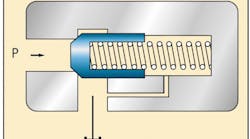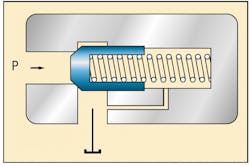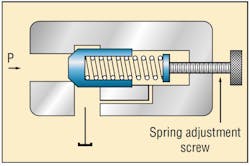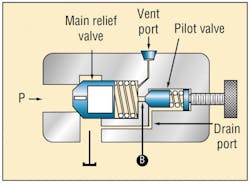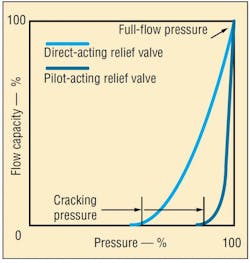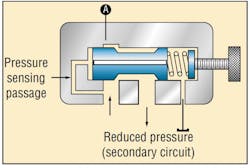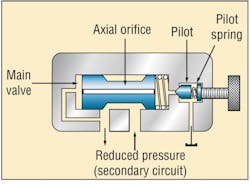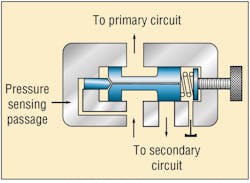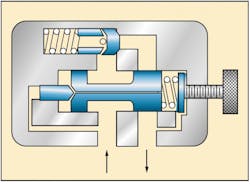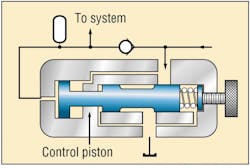Pressure-control valves are found in virtually every hydraulic system, and they assist in a variety of functions, from keeping system pressures safely below a desired upper limit to maintaining a set pressure in part of a circuit. Types include relief, reducing, sequence, counterbalance, and unloading. All of these are normally closed valves, except for reducing valves, which are normally open. For most of these valves, a restriction is necessary to produce the required pressure control. One exception is the externally piloted unloading valve, which depends on an external signal for its actuation.
Relief valves
Most fluid power systems are designed to operate within a preset pressure range. This range is a function of the forces the actuators in the system must generate to do the required work. Without controlling or limiting these forces, the fluid power components (and expensive equipment) could be damaged. Relief valves avoid this hazard. They are the safeguards which limit maximum pressure in a system by diverting excess oil when pressures get too high.
Cracking pressure and pressure override —The pressure at which a relief valve first opens to allow fluid to flow through is known as cracking pressure. When the valve is bypassing its full rated flow, it is in a state of full-flow pressure. The difference between full-flow and cracking pressure is sometimes known as pressure differential, also known as pressure override.
In some cases, this pressure override is not objectionable. However, it can be a disadvantage if it wastes power (because of the fluid lost through the valve before reaching the maximum setting). This can further permit maximum system pressure to exceed the ratings of other components. (To minimize override, use a pilot-operated relief valve.)
Relief valves are either direct-acting or pilot-operated.
Figure 1. Simple, direct-acting relief valve has no adjusting screw and therefore opens at a fixed, pre-set pressure as controlled by setting of compression spring.
A direct-acting valve may consist of a poppet or ball, held exposed to system pressure on one side and opposed by a spring of preset force on the other. In a fixed, non-adjustable, normally closed relief valve, Figure 1, the force exerted by the compression spring exceeds the force exerted by system pressure acting on the ball or poppet. The spring holds the ball or poppet tightly seated. A reservoir port on the spring side of the valve returns leakage fluid to tank.
When system pressure begins to exceed the setting of the valve spring, the fluid unseats the ball or poppet, allowing a controlled amount of fluid to bypass to reservoir, maintaining system pressure at the valve setting. The spring re-seats the ball or poppet when enough fluid is released (bypassed) to drop system pressure below the setting of the valve spring.
Because the usefulness of a fixed relief valve is limited to the single setting of its spring, most relief valves are adjustable. This is commonly achieved with an adjusting screw acting on the spring, Figure 2. By turning the screw in or out, the operator compresses or decompresses the spring respectively. The valve can be set to open at any pressure within a desired range. Aside from the adjustable feature, this valve works just like the fixed valve in Figure 1.
Spring-loaded poppet valves are generally used for small flows. They don’t leak below cracking pressure and respond rapidly, making them ideal for relieving shock pressures. They often are used as safety valves to prevent damage to components from high surge pressures, or to relieve pressure caused by thermal expansion in locked cylinders. The differential between cracking and full open pressure on spring-loaded poppet relief valves is high. For this reason they are not recommended for precise pressure control.
Figure 2. Adjustable, direct-acting relief valve blocks flow through the valve until force of system pressure on the poppet overcomes the adjustable spring force and downstream pressure.
Relief valves are also made to relieve flow in either direction. Fluid pressure at the other port acts on a shoulder on the plunger to open the valve. Another type of direct-acting relief valve has a guided piston. In this valve a sliding piston, instead of a poppet, connects the pressure and reservoir ports. System pressure acts on the piston and moves it against a spring force. As the piston moves, it uncovers a reservoir port in the valve body.
These valves have a fast response but may be prone to chatter. They can be damped to eliminate chatter, but this also slows their reaction time. They are reliable and can operate with good repetitive accuracy if flow does not vary widely. Valves with hardened-steel pistons and sleeves have a very long service life. They may leak slightly below cracking pressure unless the pistons are sealed.
Guided-piston relief valvesgenerally are used for pressures below 800 psi, although they can be made with heavier springs for higher pressures. The heavier springs give the valve a greater differential and consequently increase the size of the valve.
A variation of the guided-piston relief valve is the differential-piston relief valve. Here, the pressure acts on an annular area (the difference between two piston areas). This annular area is smaller than the valve’s seat area. This permits the use of a lighter spring than would be needed if pressure acted on the entire seat area. These valves have a lower pressure differential than poppet or guided-piston relief valves.
Figure 3. Pilot-operated relief valve has orifice through piston, which is held closed by force of light spring and system pressure acting on larger piston area at spring end.
For applications requiring valves that must relieve large flows with small pressure differential, pilot-operated relief valves are often used, Figure 3. The pilot-operated relief valve operates in two stages. A pilot stage, which consists of a small, spring-biased relief valve (generally built into the main relief valve), acts as a trigger to control the main relief valve. However, the pilot may also be located remotely and connected to the main valve with pipe or tubing.
The main relief valve is normally closed when the pressure of the inlet is below the setting of the main valve spring. Orifice B in the main valve, Figure 3, permits system pressure fluid to act on a larger area on the spring side of the poppet so that the sum of this force and that of the main spring keep the poppet seated. At this time, the pilot valve is also closed. Pressure in passage B is the same as system pressure and is less than the setting of the pilot valve spring.
As system pressure rises, the pressure in passage Brises as well, and, when it reaches the setting of the pilot valve, the pilot valve opens. Oil is released behind the main valve through passage B through the drain port. The resulting pressure drop across orifice A in the main relief valve opens it and excess oil flows to tank, preventing any further rise in inlet pressure. The valves close again when inlet oil pressure drops below the valve setting. Pilot-operated relief valves have less pressure override than direct-acting relief valves, such as in Figure 2.
Figure 4. Comparison of action of relief valves at cracking and full flow pressure.
Because these valves do not start opening until the system reaches 90% of full pressure, the efficiency of the system is protected because less oil is released. These valves are best suited for high-pressure, high-volume applications. Although their operation is slower than that of direct-acting relief valves, pilot-operated relief valves maintain a system at a more constant pressure while relieving. Figure 4 plots the operating characteristics of direct-acting and pilot-operated relief valves.
Pressure-reducing valves
The most practical components for maintaining secondary, lower pressure in a hydraulic system are pressure-reducing valves. Pressure-reducing valves are normally open, 2-way valves that close when subjected to sufficient downstream pressure. There are two types: direct acting and pilot operated.
Direct acting —A pressure-reducing valve limits the maximum pressure available in the secondary circuit regardless of pressure changes in the main circuit. This assumes the work load generates no back flow into the reducing valve port in which case the valve will close, Figure 5. The pressure-sensing signal comes from the downstream side (secondary circuit). This valve, in effect, operates in reverse fashion from a relief valve (which senses pressure from the inlet and is normally closed).
As pressure rises in the secondary circuit, Figure 5, hydraulic force acts on area A of the valve, closing it partly. Spring force opposes the hydraulic force, so that only enough oil flows past the valve to supply the secondary circuit at the desired pressure. The spring setting is adjustable.
When outlet pressure reaches that of the valve setting, the valve closes except for a small quantity of oil that bleeds from the low-pressure side of the valve, usually through an orifice in the spool, through the spring chamber, to reservoir.
Figure 5. Direct-acting, pressure reducing valve is held open by spring force. Increasing pressure at outlet port moves the spool to the right, closing the valve.
If the valve closes fully, leakage past the spool could cause pressure buildup in the secondary circuit. To avoid this, a bleed passage to reservoir keeps it slightly open, preventing a rise in downstream pressure above the valve setting. The drain passage returns leakage flow to tank. (Valves with built-in relieving capability also are available to eliminate the need for this orifice.)
Constant and fixed pressure reduction —
Constant-pressure-reducing valves supply a preset pressure, regardless of main circuit pressure, as long as pressure in the main circuit is higher than that in the secondary. These valves balance secondary-circuit pressure against the force exerted by an adjustable spring which tries to open the valve. When pressure in the secondary circuit drops, spring force opens the valve enough to increase pressure and keep a constant reduced pressure in the secondary circuit.
Fixed pressure reducing valves supply a fixed amount of pressure reduction regardless of the pressure in the main circuit. For instance, assume a valve is set to provide reduction of 250 psi. If main system pressure is 2750 psi, reduced pressure will be 2500 psi; if main pressure is 2000 psi, reduced pressure will be 1750 psi.
This valve operates by balancing the force exerted by the pressure in the main circuit against the sum of the forces exerted by secondary circuit pressure and the spring. Because the pressurized areas on both sides of the poppet are equal, the fixed reduction is that exerted by the spring.
Figure 6. Pilot-operated, pressure reducing valve has reduced pressure on both ends of the spool. A light spring holds the spool open.
The spool in a pilot-operated, pressure-reducing valve is balanced hydraulically by downstream pressure at both ends, Figure 6. A light spring holds the valve open. A small pilot relief valve, usually built into the main valve body, relieves fluid to tank when reduced pressure reaches the pilot valve’s spring setting. This fluid flow causes a pressure drop across the spool. Pressure differential then shifts the spool toward its closed position against the light spring force.
The pilot valve relieves only enough fluid to position the main valve spool or poppet so that flow through the main valve equals the flow requirements of the reduced pressure circuit. If no flow is required in the low-pressure circuit during a portion of the cycle, the main valve closes. Leakage of high-pressure fluid into the reduced-pressure section of the valve then returns to the reservoir through the pilot operated relief valve.
Pilot-operated pressure reducing valves generally have a wider range of spring adjustment than direct-acting valves and provide better repetitive accuracy. However, oil contamination can block flow to the pilot valve and the main valve will fail to close properly. Pilot-operated valves with built-in reduced pressure system relieving capability also are available.
Sequence valves
In circuits with more than one actuator, it is often necessary to drive the actuators, such as cylinders, in a definite order or sequence. One way to do this is with limit switches, timers, or other electrical control devices.
Sometimes, this result can also be achieved by sizing cylinders according to the load they must displace. The cylinder requiring the least pressure to move its load extends first. At the end of its stroke, system pressure increases and extends the second cylinder. This continues until all cylinders are actuated.
However, in many installations, space limitations and force requirements determine the cylinder size needed to do the job. In this case, sequence valves can be used to actuate the cylinders in the required order.
Sequence valves are normally closed, 2-way valves. They regulate the sequence in which various functions in a circuit occur, Figure 7. They resemble direct-acting relief valves except that their spring chambers are generally drained externally to reservoir, instead of internally to the outlet port, as in a relief valve.
A sequence valve usually permits pressurized fluid to flow to a second function only after an earlier, priority function has been completed and satisfied. When normally closed, a sequence valve allows fluid to flow freely to the primary circuit, to perform its first function until the pressure setting of the valve is reached.
When the primary function is satisfied, pressure in the primary circuit rises and is sensed in pressure-sensing passage A. This pressurizes the spool and overcomes the force exerted by the spring. The spring is compressed, the valve spool shifts, and oil flows to the secondary circuit.
Sequence valves sometimes have check valves, which permit reverse flow from the secondary to the primary circuit. However, sequencing action is provided only when the flow is from the primary to the secondary circuit.
In some applications, an interlock can prevent sequencing occurring until the primary actuator reaches a certain position. This is done with remote operations.
Counterbalance valves
These normally-closed valves are primarily used to maintain a set pressure in part of a circuit, usually to counterbalance a weight or external force or counteract a weight such as a platen or a press and keep it from free-falling. The valve’s primary port is connected to the cylinder’s rod end, and the secondary port to the directional control valve, Figure 8. The pressure setting is slightly higher than that required to keep the load from free-falling.
When pressurized fluid flows to the cylinder’s cap end, the cylinder extends, increasing pressure in the rod end, and shifting the main spool in the counterbalance valve. This creates a path which permits fluid to flow through the secondary port to the directional control valve and to reservoir. As the load is raised, the integral check valve opens to allow the cylinder to retract freely.
If it is necessary to relieve back pressure at the cylinder, and increase the force at the bottom of the stroke, the counterbalance valve can be operated remotely.
Counterbalance valves are usually drained internally. When the cylinder extends, the valve must open and its secondary port is connected to reservoir. When the cylinder retracts, it matters little that load pressure is felt in the drain passage because the check valve bypasses the valve’s spool.
Over center valves
Overcenter valves resemble counterbalance valves in that their purpose is to maintain a set pressure opposite a load, to keep it from free-falling. The main difference is that an overcenter valve uses a pilot signal, usually from the inlet of the actuator, to assist in opening the spool. This pilot assist makes the overcenter valve more efficient, and reduces the horsepower requirement and heat generation within the system.
As pumps and actuators become more advanced, with negative or positive load sensing and unloading features, and as directional control valves become more sophisticated, controlling a load smoothly using overcenter valves has, in turn, become more challenging. New advancements in overcenter valve technology are making control easier.
Unloading valves
These valves are normally used to unload pumps. They direct pump output flow (often the output of one of the pumps in a multi-pump system) directly to reservoir at low pressure, after system pressure has been reached.
The force exerted by the spring keeps the valve closed, Figure 9. When an external pilot signal acting on the opposite end of the valve spool exerts a force large enough to exceed that exerted by the spring, the valve spool shifts, diverting pump output to reservoir at low pressure.
Figure 10. Piloted unloading valve has piston with pump pressure at both ends.
High-low circuits which use two pumps for traverse and speed, or clamping, depend on unloading valves to improve efficiency. Output from both pumps is needed only for fast traverse. During feed or clamping, output from the large pump is unloaded to tank at low pressure.
Piloted unloading valves —Unloading valves are also made with a pilot to control the main valve, Figure 10. A port through the main valve plunger allows system pressure to act on both ends of the plunger. A light spring plus system pressure acting on the larger area at the spring end of the plunger holds the valve closed. A built-in check valve maintains system pressure. When system pressure drops to a preset value, the pilot valve closes. Pump flow through the port in the main valve spool closes the valve.
For more on pressure-control valves, visit our eBook chapters on the subject:
Fluid Power Basics, Ch. 9: Relief & Unloading Valves
Fluid Power Basics, Ch. 14: Pressure Control Valves (Except Relief & Unloading Valves)
Fluid Power Circuits, Ch. 16: Reducing Valves
Fluid Power Circuits, Ch. 18: Pressure Relief Valves
Fluid Power Circuits, Ch. 20: Sequence Valves
